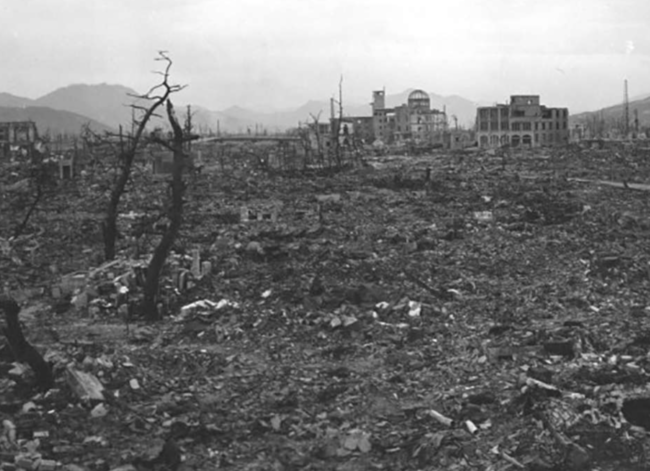On August 6, 1945, the United States dropped an atomic bomb on the city of Hiroshima in Japan. The city was obliterated. This spring break, I visited the site of the bomb and the Peace Memorial Museum near it as part of Fieldston’s Japan spring break trip.
Japan had been waging a series of regional Asian wars, invading Manchuria in 1931, China in 1937 and Indo-China/Vietnam in 1940. Japan committed numerous war crimes and crimes against humanity during its campaigns. The United States entered World War II in 1941, when Japan attacked its naval base at Pearl Harbor on December 7, 1941, killing over 2400 Americans. The United States entered World War II fighting a war against Japan in the Pacific, and Japan’s ally, Nazi Germany, in the Atlantic.
The war in the Pacific was known for its island hopping, carrier-based warfare, brutal jungle fighting, suicidal Japanese resistance by soldiers and kamikaze pilots, war crimes, the massive bombing of Japanese cities by the Americans and the brutalization of civilian populations by the Japanese. As the battles inched closer to the Japanese islands, American casualties rose exponentially.
After Allied forces defeated Germany in 1945, Japan continued to fight the United States. Seeking to force a surrender from Japan and secure a dominant position for the United States in the post-war world, President Truman approved the bombing of Hiroshima, and three days later Nagasaki, in the first use of atomic weapons in war. Japan surrendered days later.
The bombings of the two cities effectively ended World War II. Japan can claim no innocence in the war, but the casualties of Hiroshima and Nagasaki, however, were overwhelmingly civilians.
The atomic bomb at Hiroshima killed around 78,000 instantly; around 135,000 were dead by the end of 1945. That number is likely an undercount, because many people left severely burned from the explosion jumped into the river in an attempt to soothe the pain but died of their injuries, their bodies washing away in the full tide.
In the Peace Memorial Museum, one of the stops on the Fieldston Japan Trip, a glass case contains the torn clothes of children, some as young as infants, charred and ripped open by the flames. According to the memorial, “suffering severe burns, they died in pain and agony.”
Another exhibit of the museum, entitled “Human Shadow Etched in Stone,” shows a discolored spot on some stairs. The bomb’s rays directly hit the person sitting on the steps and discolored the area around him. He died instantly from the burns, leaving no body or clothes; only a slight shadow where he once sat remained.
Source: Hiroshima Peace Memorial Museum
The fatal effects of the bomb lasted far longer than the initial explosion. Immediately after the blast, radioactive black rain fell from the sky, leading to cancer and radiation poisoning. Many without visible injuries became sick and died in the weeks after August 6. The death count continued to rise every year because of radiation and cancer; some died of after-effects of the bomb decades after 1945.
Others survived the bomb and its aftermath but were left with unspeakable grief, lifelong pain, chronic illness and poverty. One father, who suffered extreme burns and lost his wife, became unable to feed his family. In the depths of physical pain, mental anguish and extreme poverty, he even contemplated killing himself and his children. Instead, he desperately fought to care for his family but faced resistance from hospitals that did not acknowledge his physical condition. The city rebuilt while ignoring many survivors, including the father, who never found relief.
The nuclear weapon responsible for the destruction and radiation, an atomic bomb code-named Little Boy, was created in Los Alamos in an initiative called The Manhattan Project. Robert J. Oppenheimer, an ECFS alumnus, led the scientific efforts.
Many ECFS students grow up in the same hallways where Oppenheimer learned. The founder of the bomb studied at ECFS and graduated before the uptown campus was built. While Oppenheimer learned classical physics at Ethical Culture, he was a dynamic force in the new field of quantum physics that surfaced in the 1920s and 1930s. Oppenheimer was the American face of a scientific revolution, and scientific revolutions, when swept up by war, can be catastrophic. Not only that, Oppenheimer directly worked on the American, Canadian and British initiatives to create the weapons used in Hiroshima and Nagasaki.
At the peace memorial of Hiroshima, the impact of the atomic bomb is on full display. On one wall, family members record the last words of their loved ones. A daughter asked, “Mother, give me water.” Her mother recounts, “When I finally brought the water, my daughter was dead.”
Other exhibits contain drawings from survivors, photographs and video footage of the bomb and its aftermath. This drawing, created by survivor Kichisuke Yoshimura, depicts people within the targeted area.
Source: Hiroshima Peace Memorial Museum
Currently, nine countries possess nuclear weapons, some more destructive than the bomb that struck Hiroshima. The global stockpile of such weapons is 13,082.
The large-scale horror of Hiroshima’s suffering illustrates the implications of that number. I left the museum haunted by not only the clothes of the dead children and the stories of the people jumping into the river with peeling-off skin but also the prospect of it happening again.






